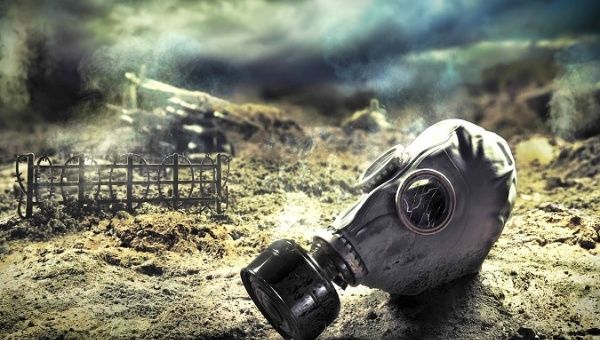With the dropping of two atomic bombs on Japan and the end of WWII,
the U.S. took over Japanese territories in Asia, including redrawing
Korea, splitting it into the northern
and southern regions at the 38th latitudinal parallel. In the south, the
U.S. occupied and set up a military base, which has remained to this
day, while the Soviet Union sent troops to the north.
Workers' Party of Korea leader Kim Il-sung became the head of the north
after a decades-long struggle against Japanese occupation. Meanwhile,
the U.S. organized and rigged elections in the south to ensure that
anti-communist Syngman Rhee won the 1948 presidential elections.
Determined to rid the country completely of occupation forces and aided
by the Soviet Union, Il-sung led the Korean People's Army against the
U.S. and its puppets in the south, easily defeating their forces in a
continuation of a communist-led people's war.
And as Cold War
tensions mounted, the United States was determined to turn back the tide
of change and revolution in East Asia. Thus began the U.S. war against
Korea in 1950.
The U.S. sent more troops to fight in the south
and began to advance north. China sent troops to the north to help
forces. By late 1951 the People's Army was gaining the upper hand.
The U.S. responded by using biological warfare, among other tactics.
In the winter of 1952 Chinese military members in the north reported,
“American aircraft were dropping strange objects” including live
spiders, flies, bees, snakes, fleas, ticks, dead rats, and mosquitos
encased in U.S. military tubes. Even dropping pork, dead crow and
chicken feathers.
The U.S. military created a policy of using “a
secret covert channel as well as on overt channel for conducting
biological and chemical warfare … whenever it was militarily
advantageous and without regard to precedent.”
A follow-up report
the authors released in 2016 detailed how 46 Chinese medical experts
investigated the creatures and found fleas with bubonic plague,
unprecedented in Korean history. Sixteen Chinese troops contracted the
disease. Civilians were diagnosed with smallpox and typhus. Korean
military documents Endicott and Hagerman uncovered show that 44 Korean
troops contracted encephalitis and meningitis and 16 died, while three
died of cholera. The U.S. military was crafting these very pathogens at
the U.S. Biological Warfare laboratories.
Some 20 military
personnel died suddenly of “acute diseases” after the presence of the
odd objects and insects in the area. The very presence of such animals,
insects and diseases were unheard of during snowy Korean winters.
Additionally, several times during the winter of 1952, the U.S.
bomb-shelled the Chinese and Korean military forces with “poisonous gas
shells” immediately killing several troops in each instance.
A
book published by the Beijing Academy of Military Science in 1982 found
that “384 Chinese soldiers were infected” with a variety of diseases
across several northern Korean provinces during the war, while 126 of
them died.
U.S. military leaders wanted to continue “the
operational use of biological agents, perhaps putting GB (nerve gas)
agents into the munitions mix." What's more disturbing than the U.S. use
of banned warfare is that the military was seemingly disappointed with
the results.
The U.S. military told its Canadian and British
partners they were unable to achieve a "highly lethal, stable, viable,
easily disseminated, low cost" agent. U.S. Chairman of the Joint Chiefs
of Staff Admiral Arthur Radford lamented that the campaign against the
north, "suffered from over-optimism and consequent attempts to get a job
done quickly."
There have been few revelations since he and
Hagerman first published their book almost 20 years ago. However,
shortly before his death, retired CIA agent Norman Cournoyer who worked
in the Biological Warfare Center in Fort Detrick broke his oath of
secrecy to the government for a 2002 documentary titled, "Code Name
Artichoke," revealing, "There were people who had biological weapons and
they used them. I won't say anything more than that. They used them.”
Despite the evidence, the United States government continues to make
every effort to cover-up, deceive and deny its criminal use of
biological weapons in the Korean War. One of the defenses of the U.S.
was that the Chinese scientists (who investigated the matter in 1952)
were poorly trained and not able to properly identify what was
happening. In fact, many of the Chinese scientists were highly trained. A
number of them had been trained in the West, including the U.S., or
studied at the Rockefeller funded Beijing Medical College. They were
well qualified to carry out the investigations and draw valid
conclusions.
Some U.S. airmen who carried out the attacks
admitted to using germ warfare after being captured by the Chinese. When
they returned home, U.S. military leaders alleged the soldiers “were
forced to confess to something that they did not do, but that what
actually happened is that when they returned home to the U.S., they were
threatened with court martial (including possible death sentences) if
they did not repudiate the confessions that they gave to their Chinese
captors.”
Despite the official coverup, G. Cameron Hurst, head of
the East Asia Department at the University of Pennsylvania called the
authors' expose book “far and away the most authoritative writing on the
subject.”
The U.S. military remains immune and unaccountable for
the deaths it caused of Chinese and Korean military as well as
civilians during the Korean War, only adding insult to injury by
covering up its germ and biological warfare campaign.

